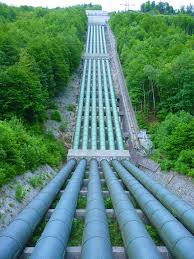The most recent
report by the American Society of Civil
Engineers (ASCE) gives a grade D+ for U.S. infrastructure
as of the end of 2013. Not a very good
grade, but an improvement over the plain D grade that had been handed out four
years earlier. With the travesty of the water
contamination in Flint, Michigan during 2014 to 2015, the ASCE report should
carry special interest. The threat to
the health of the Flint community could be found in anywhere in the U.S.
The executive summary
of the ASCE 2013 report does allow that the quality of drinking water in the
U.S. is relatively good. However, the
drinking water infrastructure is old and in too many cases the installed pipes
and valves have reached the end of useful life.
The replacement of every drinking water pipe in the U.S. - over
one million miles of water mains - would
cost more than $1 trillion at today’s prices.
For investors total infrastructure replacement value might
be misleading. What is important is
actual spending on water infrastructure.

There are about
155,000 water systems serving as much as 90% of the U.S. population. These
systems are owned by a mix of public and private owners, all of which guard
every penny received from their customers.
The U.S. Environmental Protection Agency
estimates only about 5,000 miles of water mains are replaced annually, representing a half percent of the total installed base. The represents about $5 billion in annual
upgrade spending if the ASCE is correct in its calculation of water
infrastructure value.
There is a possibility
that water system spending could increase.
At the current upgrade pace it would take 200 years to replace the
current water infrastructure, which means that water mains will need to provide
service well beyond the expected useful life of the iron pipes and valves. That does not even include new installations
to address population growth or urban expansion. Even the poorest of water system owners
probably realizes the consequences of failing to repair the system. The EPA suggests that the rate of water pipe
and value replacement could rise to 20,000 miles per year, which implies a
50-year replacement cycle for the current installed based, but somewhat slower if
urban growth is considered. That would
bring demand for water infrastructure components to $20 billion per year at
current prices.
It might be a
difficult road to reach higher water infrastructure investment. At least 80% to 90% of water system revenue
is based on volume used and water rates.
Water rates in the U.S. have been notoriously low. True enough, in recent years water rates have
been increasing at a faster pace than the Consumer Price Index (CPI),
suggesting that water system owners are trying bring collections into line with
costs. According to a water industry
research group, Circle of
Blue, water rates increased an average of 6% in 2015,
faster than most other household goods and services.
It may not be as
simple as raising water usage rates.
Water system owners also have to deal with reduced demand for
water. Flint may have awakened the
population to the threat of water contamination, but California’s severe
drought conditions also brought to the collective conscious the importance of
conserving water supplies. A survey
completed by Circle Blue found that total water usage declined in several major
cities in 2014, including Austin, Las Vegas, Phoenix and Las Angeles.
In the next few
posts we will look at companies producing the pipes, values and components that
are used to construct our drinking water infrastructure. We will try to answer the question, does the
large installed based and imperative to improve also mean opportunity for sales
and profits for the pipe and value folks.
Neither the author of the Small Cap Strategist web
log, Crystal Equity Research nor its affiliates have a beneficial interest in
the companies mentioned herein.
No comments:
Post a Comment